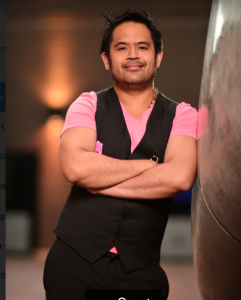C. E. Gatchalian
In short, I woke up and began feeling, if not yet living, outside my head. That’s what happened when I first encountered A Streetcar Named Desire.
May 5, 1987
Spent seven hours again today practising. After not a single first-place finish at the festival I must do everything to ensure only victories at the next one. Spent two and a half hours on Bach, two and a half on Beethoven, two on Chopin, who comes to me more easily as he is soft and frail like me; but Bach and Beethoven, whom I admire more, I must work on—they are subtler yet more solid, marmoreal, exposed. While practising the second movement of the Italian Concerto today, my eyes were closed and for two seconds I saw God. So this is why I play the piano—thank you, God, for reminding me.
[This Filipino queer boy’s single-minded focus on Western high art affirms and perpetuates familiar hegemonies.]
This essay deploys three distinct voices: the Journal Voice, the voice of my utterly colonized thirteen-year-old self; the Bracketed Voice (not to be confused with passages in parentheses), stridently political, always deconstructing, recalcitrant against erasure; and the Voice Proper (of which this section is an example), centrist apologist for both progressive politics and belles lettres. I defend this choice of form over more conventional ones, as it reflects more precisely my conflicted feelings about this masterpiece.
◊ ◊ ◊
My first exposure to Streetcar was not the 1951 Vivien Leigh–Marlon Brando film version, but the far less heralded 1984 television adaptation starring Ann-Margret and Treat Williams.
What I most remember from the film was the heat. The heat of a world of inverted values, where unadulterated physicality assumed absolute primacy. Of unapologetic, brutal, sweat-soaked masculinity. Of words slipping and sliding against one another with poetic abandon.
I was thirteen when I saw it. Complete innocence was just behind me and I was at the threshold of awareness. I wasn’t yet able to put words to my feelings, but Streetcar seemed to speak them for me.
It would be too obvious—and not quite accurate—to write about how Stanley Kowalski ignited lust in me (though he did) or how in his dainty, ethereal sister-in-law Blanche DuBois I saw a reflection of myself (though I did)—at thirteen, I wasn’t yet able to be completely honest with myself on those fronts. My identification with Streetcar was at once more miasmic and visceral—it hit my very core, addressed a sense of life that was still in embryo.
◊ ◊ ◊
By “sense of life” I mean a worldview, a way of approaching and receiving the world, the highly individual filters through which one makes of the world one’s own private melodrama. When I first encountered Streetcar, my melodrama as a brown queer boy was just starting to find its particular plotlines, tensions. What was forming was a variation on the Christian stance of being in the world but not of it—and by “variation” I mean a shift from the familiar Biblical context to one that could encompass a somewhat more profane brand of outsider-dom.
But there was something else happening, an agon between two distinct versions of self. To borrow from Jacques Lacan’s theory of the mirror stage, there was my actual, bodily self, awkward, gawky and, quite possibly, I was starting to sense, deviant; and the self I saw reflected in my piano-playing and writing, the two artistic activities in which I was knee-deep at the time: a self that was adroit, high-minded, coherent.
This clash I saw reflected in Streetcar. Blanche DuBois, as nuanced and conflicted a heroine as any created by Sophocles or Shakespeare, clings to the rarefied virtues of chivalry and high art while wrestling with her hungering, daemonic animal self. She lays out her ideology in her famous scene 4 monologue, in which she warns her sister about Stanley:
He acts like an animal, has an animal’s habits! Eats like one, moves like one, talks like one! There’s even something—sub-human—about him—something not quite at the stage of humanity yet! Yes, something—ape-like about him, like one of those pictures I’ve seen in—anthropological studies! Thousands and thousands of years have passed him right by and there he is—Stanley Kowalski—survivor of the Stone Age! Bearing the raw meat home from the kill in the jungle! And you—you here, waiting for him! … Maybe we are a long way from being made in God’s image, but Stella—my sister—there has been some progress since then! Such things as art—as poetry and music—such kinds of new light have come into the world since then! In some kinds of people some tenderer feelings have had some little beginning! That we have got to make grow! And cling to and hold as our flag! In this dark march toward whatever it is we’re approaching … Don’t—don’t hang back with the brutes!
Unfortunately, this beautiful monologue, which springs from the profoundest wells of Blanche’s spirit and sense of life, is too often played for facile laughs, as an opportunity for audiences, which are largely, at least in North America, democratic and anti-elitist, to snicker at a pretentious and uppity woman. (Of all the Blanches I’ve seen only Vivien Leigh—appropriately enough, a Brit—delivers it with the necessary soulful sincerity.) In fact, this monologue is an impassioned apologia for high culture, and as a burgeoning artist/aesthete/gay man, high culture was something I could easily get behind. At thirteen I already knew that there was an incontestable link between queers and art; and while I couldn’t yet identify as queer, I was ready to identify as an artist.
As an artist, therefore, I would only align, could only align, with the rarefied, the singular, the difficult. “Superior things! Things of the mind and the spirit!” exclaims Amanda Wingfield in The Glass Menagerie, another of Tennessee Williams’s transcendence-seeking Southern Gothics. In my high school law class during a discussion on crime I haughtily offered my lack of sympathy to those who committed violence in self-defence: “Instincts are for animals,” I said, paraphrasing another of Amanda’s lines—an opinion that was roundly sneered at but for which I was unrepentant.
For I had successfully convinced myself that I was a prince among peasants. I was immersed in art, literature, music. I had imbibed the mutterings of Ayn Rand and declared myself an objectivist (I hadn’t yet happened upon her homophobic views, but neither had I come out to myself, so I doubt it would have made much difference). Later I would read Plato’s Republic and the writings of Edmund Burke and identify my politics as firmly right-of-centre, aligning against the gutter mentality that flourished under the rubric of “democracy.” And I would take to heart Yukio Mishima’s advice that homosexuals always support the Right, for they have everything to lose from majority rule. (Again I was still a number of years away from coming out, but for reasons that were yet unknown to me this dictum stuck.) At my loopiest I declared that while fascism was an undesirable extreme, its sense of form and proportion was at least aesthetically beautiful.
July 25, 1988
Hottest day of the summer so far. I sit upright at my desk in an effort to get away. The heat, the garish sun, those bodies—revolting.
It should be illegal for people to take their shirts off in public. It is an unnecessary hindrance, an infelicitous roadblock on the path to one’s sole and proper objective: intellectual elevation.
The greatness of Streetcar lies in the parity, the equal attention it gives to the dueling sides of our binaries—the spirit and the flesh, the constructed and the chthonic, Apollo and Dionysus, art and ardour. Art is manifest in Blanche’s florid sentences, her tragically tawdry refinery, her moth-like, flutteringly defiant stand against what she calls “deliberate cruelty.” The New Orleans of the play is a den of lustful, ravenous Darwinism; she suffers through her various indignities like a sheet-white relic of Old World gentility, all the while uttering some of the sublimest lines in American dramatic literature. But this lustful, ravenous Darwinism is given more than its due, suffusing Blanche DuBois in a thrillingly Boschian polychromatism. Brawny, brutal, roughhousing poker players; sweat-soaked street vendors and grotesque Mexican flower ladies; a fecund young wife and her beautiful, virile husband, igniting coloured lights with their insatiable fornicating. The central agon in the play, that between Blanche and Stanley, is all the more wrenching because at every step it is also a mating dance. The rape of Blanche DuBois has layers, depth, for it is also quite surely a consummation, a fulfillment—a final surrender to the promptings of her own sexual nature.
But at the end, and above everything else, metatheatrically transcending the sordid proceedings like some divine reminding presence, is the play as a work of art, as technically seamless as any ever written. Its architectural ingenuity—how Blanche’s destruction is a structural echo of her dead husband’s; its dazzling surface—the plethora of poetic imagery, the purposeful allusions to Philomela, Procne, Tereus, interlocking, interweaving, simultaneously deepening and elevating; its masterful aurality—the antagonists’ disparate semantic structures conjoining in a dissonant harmony, like some inexplicably pitch-perfect hybrid of Mozart and Schoenberg: at the end, and above everything else, it is a work of beauty, aching in its formal finish, triumphant and all-redeeming.
[There’s something unethical—amoral—about this New Critical exaltation of form … something cowardly, snail-like, like Nero fiddling while Rome burned.]
March 21, 1988
There is nothing more beautiful than J. Today in French class I was given his quiz to mark. Typical dumb jock—he scored 2 out of 10. When I gave him back his quiz he said, “I know, I’m a total lame-o. Embarrassing. Thanks dude.” I caught a glimpse of his blue eyes—they radiate kindness, something I had never seen before in any male—those linear, solipsistic creatures, as fascistic and indifferent as fate. But today the plaster cracked, in the face of J, Adonis incarnate. A new paradigm, exemplar, for everything I want to be.
Blanche DuBois’s stature in gay male culture is unquestioned. Gay men will call each other “Blanche” in moments of teasing, gentle censure; her most famous lines are fixtures in the cultivated gay man’s repartee bank; she figures in works as diverse as All About My Mother and The Golden Girls. The oft-iterated deconstruction of Blanche as a gay man in drag is too crass, if not wholly inaccurate. A more precise explanation for her popularity is that Blanche makes the suffering of gay men visible; that she suffers for us, that the path of debasement she travels is actually our own.
And yet, Blanche is a homophobe. She marries a closeted young poet named Allan who’s possessed of “a nervousness, a softness and tenderness which wasn’t like a man’s.” He came to her “for help”: “He was in the quicksands and clutching at me, but I wasn’t holding him out, I was slipping in with him!” She exposes him for who he is after she walks in on him with a man: “I saw—I know—you disgust me,” she says, her words reverberating with the weight of centuries of heterosexist bigotry. He then sticks a revolver fellatio-style in his mouth and blows his head off, following the classic triadic sequence of homosexual immolation: consummation, exposure, suicide.
But Blanche gets her comeuppance. Indeed, with a classical symmetry that gives Streetcar the rightness and inevitability of Greek tragedy, her downfall matches Allan’s step for terrifying step. Just as Allan tried to play it straight, Blanche attempts to play it prim, sweeping her dissolute past beneath a veneer of hyper-ladylike gentility. Her numerous illicit affairs are discovered then brutally exposed by both the effeminate Mitch and the thuggish Stanley. Both attempt to rape her; Stanley succeeds and drives her to madness, her mental death a direct analogue to Allan’s physical one. In the end, Blanche retreats to the one safe space available to the homosexual: the beauty-laden, reality-altering confines of the mind.
◊ ◊ ◊
As for Stanley Kowalski, he provides an occasion, in these socio-politically volatile times, for non-dualistic thinking. He is opposed to virtually everything I have extolled and elevated my entire life; nonetheless, this wife-abuser and rapist has my affection. The scrappy, ambitious child of Polish immigrants, he is a forthright working-class husband and expectant father making do in an economic system not of his choosing. The very real threat posed by his aristocratic sister-in-law explains, if not justifies, his crassness and brutality; beneath the hyper-macho pyrotechnics is abject fear.
As for Stanley’s beauty—so indelibly embodied by both Marlon Brando and Treat Williams—it proves, for the character, a double-edged sword. Sex being the great equalizer, it levels the playing field between him and Blanche: pulling her down to his turf, he reduces her to an animal. But ultimately it works against him, facilitates his eventual emasculation; for he becomes a sex symbol (as embodied by the young Brando, the first real male sex symbol in Western popular culture), still lusted after, to this day, by the very demographic—male homosexuals—Blanche stands in for. As Stanley himself objectified, he, in turn, is objectified. Blanche has her triumph. The circle is complete.
[Treat Williams’s Stanley Kowalski was the first person this boy masturbated to, the boy being the penetrator in the fantasized scenario. In hindsight, he may have subconsciously been retaliating on Blanche’s behalf.]
The mind—still the place I run to when times get tough. My escapes have never been via alcohol or drugs or sex, but by retreating completely from external reality and into the grimly gnostic crevices of my mind. The dominance of interior settings in Harold Pinter’s work, it has been said, is a physicalization of the protection Jews have historically found in the mind, an oasis of freedom and safety in an anti-Semitic world. Queers, too, like Jews, have found solace in the mind, and, like Jews, have entered the creative fields in disproportionate numbers.
April 6, 1988
J has stopped saying hi to me. Up till last week he’d say hello whenever he saw me. Then he caught me staring at him. He hollered, “Do you have a problem?” I was frozen, speechless. He rolled his eyes and stormed away.
Obviously I have a problem. One of the few men who I thought was different is just as godforsaken, as vile, as plebeian as the rest of them. He ignores me, looks right past me. I will retaliate, he will do right by me. If not I will kill myself.
I stepped outside my head. The results were disappointing.
Upon seeing Streetcar, I came out to myself—formally, officially, with the bushy-tailed, starry-eyed obdurateness of a postulant nun—as an artist. I wanted entry into Art’s inviolable order. Within its confines I would be safe.
Blanche DuBois—the romantic idealist who defied repugnant, brute reality—became my patron saint. I came to see her fate not as oversensitivity, not as insanity, but rather as self-removal from the philistinism of the earth below.
[A Streetcar Named Desire is not about Blanche DuBois. It is about Allan Gray.
The play’s characters are all fragments of the character Allan would or should have been. Every character is an imposter, taking space away from what would or should be Allan’s.
Tennessee Williams denied him stage life—denied him appearance, body, voice.
The greatest queer playwright of the twentieth century was complicit in his kind’s own minimization.]
 Born, raised and based on the unceded traditional lands of the Coast Salish peoples (Vancouver), Filipino-Canadian author C. E. Gatchalian writes drama, poetry, fiction and non-fiction. His plays, which include Falling in Time, Broken, Motifs & Repetitions, and People Like Vince, have appeared on stages nationally and internationally, as well as on radio and television. A two-time finalist for the Lambda Literary Award, he was the 2013 recipient of the Dayne Ogilvie Prize, awarded annually by The Writers’ Trust of Canada to an outstanding emerging LGBT author. He is currently completing a non-fiction work called Double Melancholy, of which this essay is a part.
Born, raised and based on the unceded traditional lands of the Coast Salish peoples (Vancouver), Filipino-Canadian author C. E. Gatchalian writes drama, poetry, fiction and non-fiction. His plays, which include Falling in Time, Broken, Motifs & Repetitions, and People Like Vince, have appeared on stages nationally and internationally, as well as on radio and television. A two-time finalist for the Lambda Literary Award, he was the 2013 recipient of the Dayne Ogilvie Prize, awarded annually by The Writers’ Trust of Canada to an outstanding emerging LGBT author. He is currently completing a non-fiction work called Double Melancholy, of which this essay is a part.






